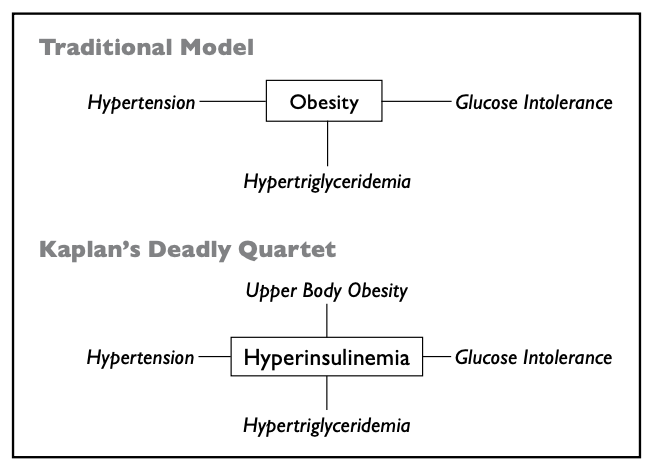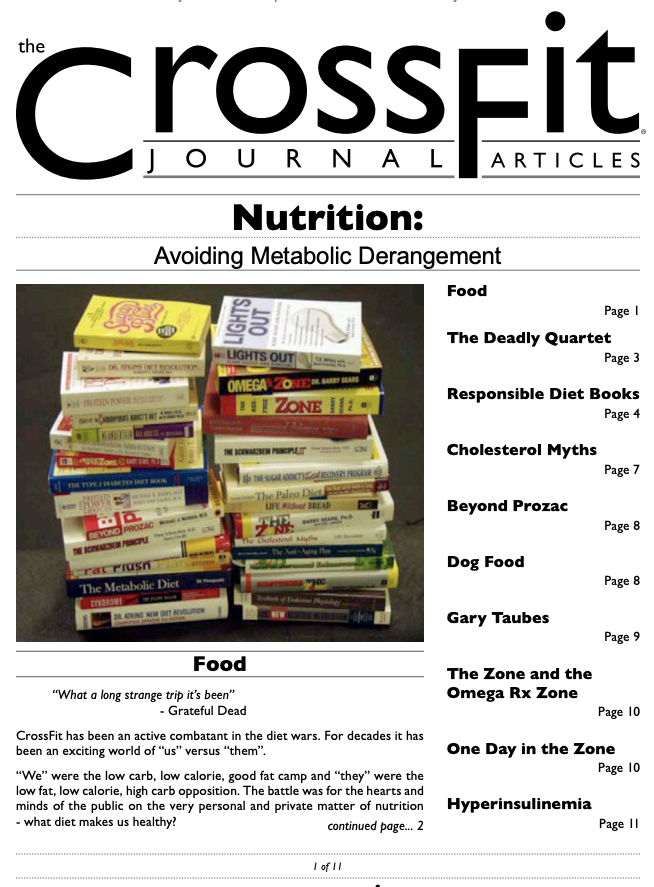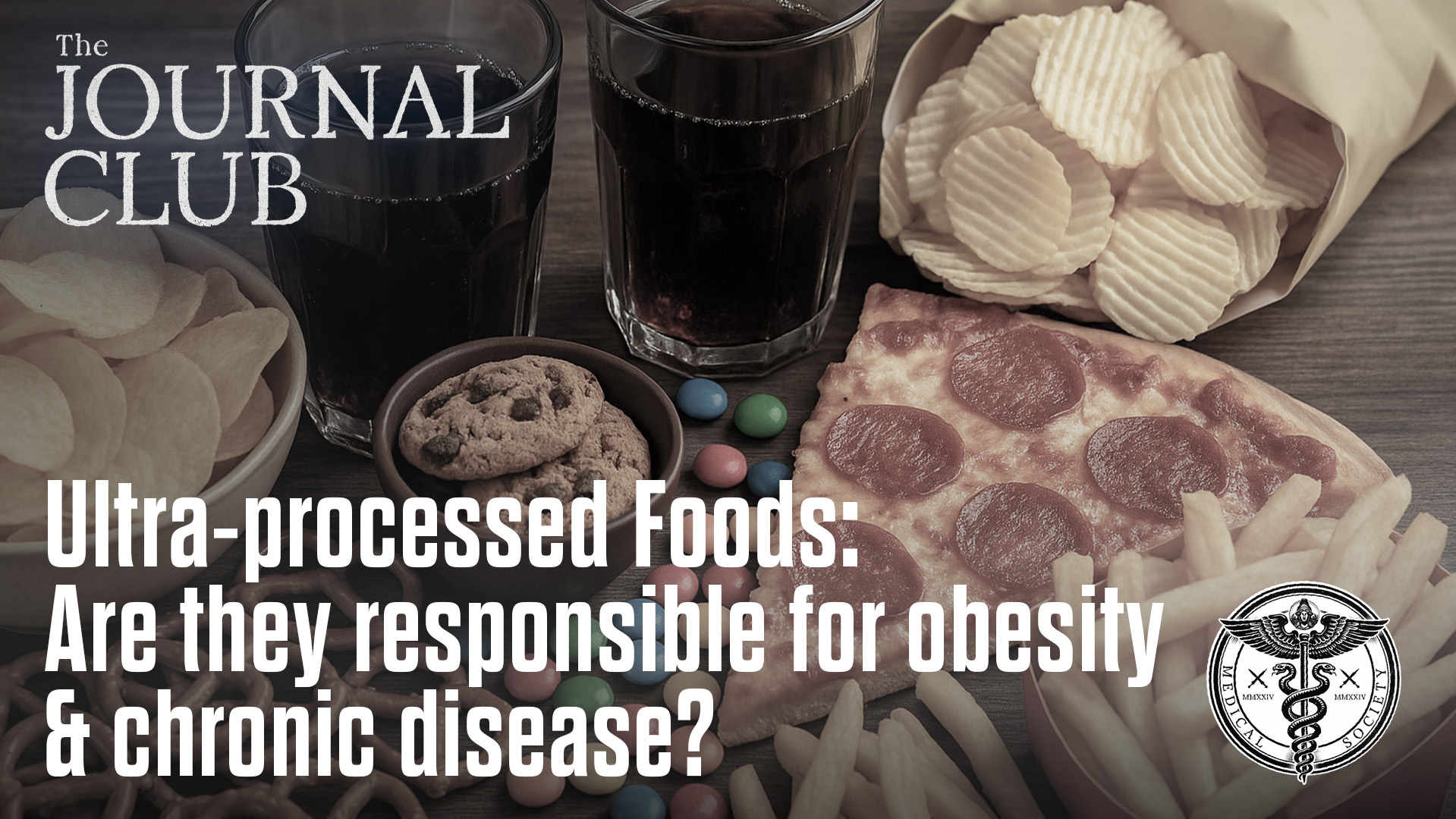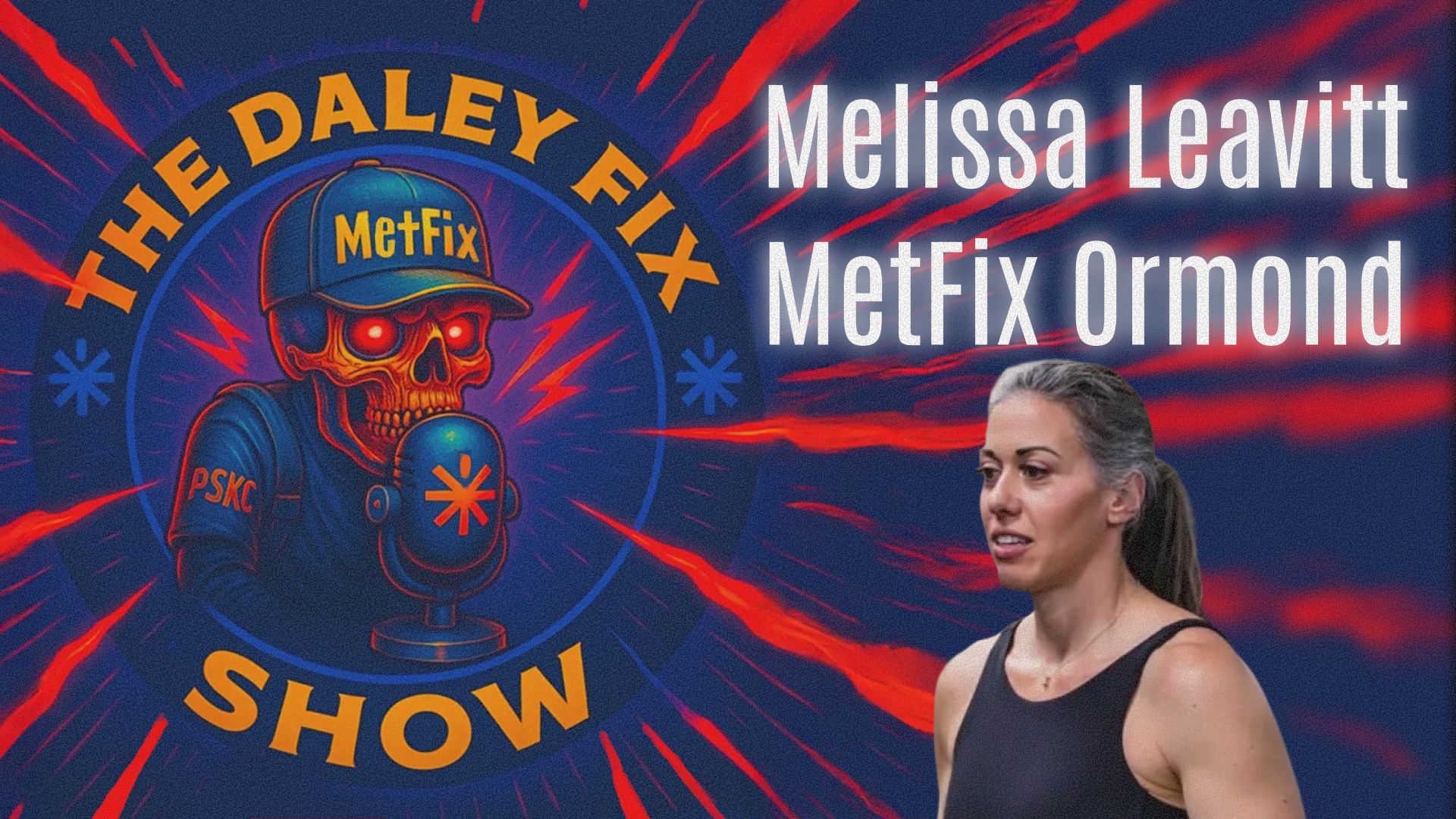Food
“What a long strange trip it’s been”
– Grateful Dead
CrossFit has been an active combatant in the diet wars. For decades it has been an exciting world of “us” versus “them”.
“We” were the low carb, low calorie, good fat camp and “they” were the low fat, low calorie, high carb opposition. The battle was for the hearts and minds of the public on the very personal and private matter of nutrition – what diet makes us healthy?
Sheldon Margin, publisher of the UC Berkley Wellness Letter, a leader of “them”, accepted this characterization of battle lines when we presented it to him in 1996. In 1996 Dr. Atkins and Barry Sears were both publicly and regularly referred to as “quacks” and “frauds” by mainstream physicians, journalists, and nutritionists. While this was something that Sears would have to get used to, Dr. Atkins had been dealing with vicious assaults on his life’s work and character since publishing his Dr. Atkins’ Diet Revolution in 1972.

We write here today in 2003 gloating. Gloating, because it is our perception that we are decisively winning the diet war. In the public square, the realization that carbs, not fat, make you sick and fat is spreading rapidly. Spreading like truth unobstructed. The position that carbohydrate is essentially toxic at common consumption levels was a truth suppressed by political and industrial corruption of science and journalism. Suppressing truth is like holding a beach ball under water; it takes constant work against a tireless resistance. They have slipped and our position sits like the beach ball on top of the water, where everyone can see it.
We interpret our position of being clearly visible, as winning the diet wars because our diet better models human nutrition and will always trump the opposition’s model if tested. Ours works, theirs doesn’t. Where theirs does work, ours works better. Their success required our being kept out of the marketplace. Underwater preferably.
In countless exchanges with doctors, trainers, nutritionists, and family we shared our position and the common response was, “do you have any science? I need science.” We had science and showed it proudly. No one would read it. The cry for peer-reviewed evidence is almost always a smoke screen. The guys who write it read it – the rest pretend. If you can train people to unquestioningly accept proposition X then you’ve largely inoculated these same folks from even considering “not X”.
The science supporting our position while being produced at an increasing rate, was always there and is not responsible for the dramatic change over the last two years.
What has changed is that the public bought some 100 million diet books over the last thirty years running the most important and successful science experiment ever conducted. To a constant and universal barraging of the fat is bad mantra from public health authorities, millions of people with no clinical or scientific credentials tried regimens found in “dangerous” books and found some of them marvelously effective.
Doctor Robert Atkins deserves credit for suffering unimaginable abuse while remaining steadfast, Gary Taubes for being the first journalist to expose the fraud and origins of the low fat position and for later making the point that the science may have been behind Dr. Atkins all along, Barry Sears for super tuning a responsible diet, and Dr. Uffe Ravnksov for exposing the fraud and slop in anti-fat research so effectively that he needed to be completely ignored to be dealt with.
But the true heroes are each and every one of you who thought for yourselves, ignored the chorus of doctors, nutritionists, journalists and neighbors bleating like sheep, “faaaat is baaad”, followed the logic of reduced carbohydrate consumption, and then critically and most importantly, tried the diet. You try one diet and you feel great, you try another and your teeth fall out. Who needs a doctor?
Patients are telling their doctors about the Zone and Protein Power and Atkins, not the other way around. Doctors everywhere are themselves doing the Zone and Atkins on the advice of their patients – on seeing their patients’ successes. The peer reviewed literature remains unread, but, the reverberation of the good diet books message is working its way from author to reader to doctor and finally back to patients.
Perhaps, this process isn’t so unusual but merely another example of the efficiency of decentralized networks. In any case it is consistent with this bit of philosophy from Dr. Uffe Ravnskov’s epilogue to The Cholesterol Myths:
“After a lecture, a journalist asked me how she could be certain that my information was not just as biased as that of the cholesterol campaign. At first I did not know what to say. Afterwards I found the answer.
She could not be certain. Everyone must gain the truth in an active way. If you want to know something you must look at all the premises yourself, listen to all the arguments yourself, and then decide for yourself what seems to be the most likely answer. You may easily be led astray if you ask the authorities to do this work for you.
This is also the answer to those who wonder why even honest scientists are misled. And it is also the answer to those who after reading this book, ask the same question.”
The Deadly Quartet
Clinicians and researchers have long recognized the clustering of risk factors for heart disease. Physicians have known for decades that obesity, glucose intolerance (a precursor and measure of diabetes), hypertension, and hypertriglyceridemia tended to coexist in the same person and are predictive of heart disease.
Furthermore, physicians had noticed that glucose intolerance, hypertension, and hypertriglyceridemia lie in store for patients who’d become overweight. The assumption was that because the obesity came first that it was the cause of the other risk factors. While this is a natural assumption it is nevertheless a classical logical fallacy – Post hoc, ergo propter hoc (After this, therefore because of this.)
This traditional view of obesity as the cause of glucose intolerance, hypertension, and hypertriglyceridemia was seriously challenged when Dr. Norman Kaplan head of the Hypertension Division at the University of Texas Southwestern Medical Center at Dallas published an article in the July 1989 Archives of Internal Medicine entitled “The Deadly Quartet” When Dr. Kaplan examined the research, he found that obesity is not the cause of glucose intolerance, hypertension, and hypertriglyceridemia but merely a correlate.

Dr. Kaplan went on to demonstrate that hyperinsulinemia, another correlate of each of the traditional risk factors, can be more realistically represented as the cause of glucose intolerance, hypertension, hypertriglyceridemia, AND obesity (upper body obesity specifically).
The importance of this work is hard to overstate. Treating glucose intolerance, hypertension, hypertriglyceridemia, and obesity as separate diseases had not yielded impressive results and all too often treatment for one of these diseases exacerbated the rest (e.g., Dean Ornish’s diet worsens triglycerides while reducing obesity and hypertension).
What would be a legitimate test of Dr. Kaplan’s hypothesis? Well, if hyperinsulinism is the root cause of glucose intolerance, hypertension, hypertriglyceridemia, and obesity then reducing hyperinsulinism should reduce the occurrence of the correlated risk factors and it does.
Dr. Kaplan suggested convincingly that hyperinsulinism was the cause of heart disease risk factors in 1989, but Dr. Robert Atkins had been making the same point since 1972 and had proven it in thousands, if not millions of persons who’d followed his book, Dr. Atkins’ Diet Revolution. One of many lessons that can be garnered from this history is that the astute clinician will often trump the researcher by decades, which brings us to a final point – there are two serious problems with medical science today: first that correlation and causation are tragically confused by many researchers and second, that there is low regard and little interest among academics with the often highly successful protocols employed by clinicians.
Responsible Diet Books
These authors understand the double-edged nature of blood glucose control, i.e., hormonal regulation and caloric restriction. Our cast includes a lipidologist, cardiologist, psychiatrist, nephrologist, an exercise physiologist, pathologist, practicing and research endocrinologists, biologists, an attorney, journalist, and falconer. They largely quote the same published research and have come to the same conclusion: the low fat/high carb diet is lethal.
Barry Sears PhD:
Enter the Zone
A Week in the Zone
The Top 100 Zone Foods
The Age-Free Zone
The Soy Zone
Mastering the Zone
Zone Food Blocks
Zone-Perfect Meals in Minutes
The Omega Rx Zone
Robert Atkins, M.D.:
Dr. Atkins Diet Revolution
Dr. Atkins New Diet Revolution
Dr. Robert Atkins held fast to the notion that hyperinsulinism brought on by excess carbohydrate consumption was at the root of obesity and other risk factors for coronary heart disease in spite of a torrent of criticisms and claims of quackery heaped on by the collective medical establishment. His citing of studies and his super impressive clinical record carried little sway among the mainstream advocates of the high-carb/ lowfat fad diet.
Dr. Atkins first book, Dr. Atkins’ Diet Revolution, contains his responses to the American Medical Association’s condemnation of his diet and the subsequent investigation of his regimen by the Senate Select Committee on Nutrition and Human Needs. Remember from Gary Taubes that it was this Senate Select Committee, chaired by George McGovern that largely sponsored, promoted, and funded the low fat high carb diet that has destroyed the health of countless millions. (It’s not surprising to see that socialists through their collective vision for us all have done for health and nutrition what they’ve done for economics and human rights.) The A.M.A. is not likely to reverse its negative impact on human health in a thousand years of good deeds.
William Dufty:
Sugar Blues published in 1975 proclaimed that sugar was a poison responsible for unimaginable disease and suffering. A million copies of this little book were sold and the medical establishment laughed. Oooops, he was right! To read Sugar Blues in light of modern research, a more enlightened medical community, and the legacy of the high carb/low fat diet is spine chilling.
Drs. Michael and Mary Dan Eades:
The Protein Power Lifeplan Michael Eades is a very good writer, and Protein Power has been an accessible introduction to responsible nutrition. The Eades’ examination of research on diet and heart disease is outstanding. The book is great; the diet is good. For many this book has resonated where the Zone may have been impenetrable.
Michael Norden, M.D.:
Dr. Michael Norden, a psychiatrist and pioneer researcher, explains in Beyond Prozac how the high carb/low fat diet is directly responsible for a pandemic of mental illness and mood disorder ranging from alchoholism to depression and anxiety attacks. Norden reveals that the Zone Diet has to date been the most effective clinical treatment for a long list of psychological maladies.
We’d seen this effect of the Zone Diet long before Beyond Prozac was published. We had a file full of testimonials regarding mitigation of mental disorders after following the Zone and weren’t sure what to make of them until this book hit the market in 1996.
Uffe Ravnskov, M.D., PhD:
Dr. Ravnskov has “no dog in this fight”. He advocates no diet, but what he does say and quite convincingly is that the connection between the consumption of saturated fats, high cholesterol and cardiovascular disease, known as the “diet-heart” idea, is built on a house of sand.
Ravnskov has impeccable credentials as a researcher and clinician and his understanding of the research surrounding the statins, cholesterol management, and cardiovascular disease is unrivaled. Ravnskov brings an understanding of experimental protocol and design to the discussion that is also singularly unique.
Drs. Richard and Rachael Heller:
The Carbohydrates Addicts Diet
Healthy for Life
The Heller’s bring an amazing personal and professional history to the understanding of hyperinsulinism. The Heller’s are both distinguished professors of medicine at Mount Sinai School of Medicine in New York.
Ray Audette:
Neanderthin is a delightfully written presentation of the paleodiet position: “if a caveman could hunt it or gather it to eat, so can you.”
Loren Cordain, PhD:
Dr. Cordain is widely acknowledged as the world’s leading authority on Paleolithic nutrition. The Paleo Diet elaborates brilliantly on the discordance brought on by a diet sharply at odds with our biological development and design.
Roy Walford, M.D.:
The Anti-Aging Plan
Maximum Lifespan
The 120-Year Diet
Dr. Walford is the undisputed leader of longevity researchers. This U.C.L.A. pathologist has been studying and thinking about longevity since high school. It is impossible to research caloric restriction and longevity without finding his work.
Calvin Ezrin, M.D.:
The Endocrine Control Diet
The Type 2 Diabetes Diet Book
Calvin Ezrin discovered the thyrotroph, the cells within the pituitary gland responsible for production of thyroid stimulating hormone, as a young researcher under Banting and Best, the discoverers of insulin. A pioneering endocrinologist, Dr. Ezrin has never found a physician willing to publicly and directly answer his claims of the entirely beneficial effects of ketogenic diets. It has long been easier to ignore this scientist and physician than to take him on.
The Endocrine Control Diet and the Type 2 Diabetes Diet Book are one and the same book. In his book, Dr. Ezrin has published a letter, “Doctor to Doctor” in which he offers his help in understanding benign dietary ketosis and offers assistance to any physician willing to contact him.
We’ve found Dr. Ezrin to be of enormous benefit to every diabetic we’ve sent his way.
T.S. Wiley and Bent Formby, PhD.:
Lights Out: Sleep, Sugar, and Survival
Wiley and Formby continue in the vein of Norden’s Beyond Prozac with compelling evidence of the scientific link between insufficient sleep and the metabolic derangement of hyperinsulinism. This is a powerful premise with strong support.
Gerald Reaven, M.D., Terry Kristen Strom, M.B.A., Barry Fox, PhD.:
Nobody has done more scientific research on the metabolic derangement caused by hyperinsulinism than Dr. Reaven. This derangement is widely referred to as “syndrome X” in medical circles, a label first given by Dr. Reaven.
Dr. Reaven has been rabidly critical of every attempt to mitigate “syndrome X” by reducing carbohydrate intake until he published his book in 2000. He repeatedly cites studies that show that weight loss is equivalent with isocaloric diets of varying macronutrient composition. It is hard to believe that a man of Reaven’s background and knowledge doesn’t know that all twenty-pound weight losses are not equally beneficial. This, and his harsh criticism’s of Atkins and Sears, suggest the possibility of an integrity problem with Dr. Reaven.
Diana Schwarzbein, M.D.:
The Schwarzbein Principle
The Schwarzbein Principle II
Diana Schwarzbein is an endocrinologist sub-specializing in diabetes, osteoporosis, menopause and thyroid conditions.
Mauro DiPasquale, M.D.:
The Anabolic Diet
The Metabolic Diet
Dr. DiPasquale is the father of the cyclical diet of which Natural Hormonal Enhancement is an indistinguishable variant. In practice this diet looks like Atkins with one or several nasty cheat days per week. The Anabolic Diet crowd found strong and articulate proponents among academics, coaches, and athletes interested in power sports. The debates between the Zone crowd and the Anabolic crowd have been destructive of both camps and resolved nothing.
Dr. DiPasquale’s knowledge of and position as an authority on anabolic steroids and the unfortunate public association of the word “anabolic” with steroids probably doomed his diet to obscurity. It works, and works very well.
Christian Allan, PhD, Wolfgang Lutz, M.D.:
Life without bread is an excellent presentation of the scientific literature on carbohydrate metabolism–a subject to which both authors have dedicated their scientific careers.
Jennie Brand-Miller, PhD, Thomas M.S. Wolever, M.D., PhD, Kaye Foster-Powell, M. Nutr. & Diet., Stephen Colagiuri, M.D.:
This book bills itself as “The Authoritative Guide to the Glycemic Index”. It may be just that.
Rob Faigin, J.D.:
Natural Hormonal Enhancement (NHE)
Natural Hormonal Enhancement owes considerably more to Mauro DiPasquale and the Anabolic Diet than its author credits. An entertaining compendium of responsible works, NHE leaves us with the suspicion that Faigin, an attorney, hasn’t been able to separate theory from effective programming.
Although none of the nutrition gurus reviewed here’s exercise advice matches the quality or effectiveness of their nutritional regimens, but Faigin’s exercise views come right from the muscle magazines. NHE is an exciting brew of sound science, untested theory, and the best of the bodybuilding magazines.
Cholesterol Myths
Everyone knows by now that the consumption of animal fats and cholesterol causes heart disease. There is, though, one simple problem with this knowledge: it is absolutely, positively, dead wrong, and no one can make this point more convincingly than Dr. Uffe Ravnskov in his wonderful book The Cholesterol Myths.
Dr. Ravnskov armed with a brilliant mind, a PhD in chemistry, an M.D., and an unassailable record of published medical research is the medical counterpart to science journalist Gary Taubes in loudly yelling “The Emperor has no Clothes!!”
Here, thanks to Dr. Ravnskov, are some important cholesterol facts and their scientific support. There is more research available through this portal than could be studied in a year. Enjoy!
Here is an excerpt from an excellent review of Cholesterol Myths off of the Weston A Price Foundations website by Stephen Byrnes, N.D., RCNP:
“Would you buy a book that was literally set on fire by its critics on a television show about it in Finland? I would and so should you. The longawaited English version of debunker extraordinaire Dr. Uffe Ravnskov’s notorious book is now available from NewTrends Publishing.
Ravnskov, a medical doctor with a PhD in chemistry, has had over 40 papers and letters published in peer-reviewed journals criticizing what Dr. George Mann, formerly of Vanderbuilt University, once called “the greatest scam in the history of medicine,” namely the Lipid Hypothesis—the belief that dietary saturated fats and cholesterol clog arteries and cause atherosclerosis and heart disease.
Equipped with a razor-sharp mind and an impressive command of the literature, Ravnskov methodically slaughters the most famous sacred cow of modern medicine and the most profitable cash cow for assorted pharmaceutical companies. Sparing no one, Ravnskov again and again presents the tenets of the Lipid Hypothesis and the studies which supposedly prove them, and shows how the studies are flawed or based on manipulated statistics that actually prove nothing.”
Cholesterol Facts
- Cholesterol is not a deadly poison, but a substance vital to the cells of all mammals. There are no such things as “good” or “bad” cholesterol only density. Mental stress, physical activity and change of body weight may influence the level of blood cholesterol. A high cholesterol is not dangerous by itself, but may reflect an unhealthy condition, or it may be totally innocent.
- A high blood cholesterol is said to promote atherosclerosis and thus also coronary heart disease. But many studies have shown that people whose blood cholesterol is low become just as atherosclerotic as people whose cholesterol is high.
- Your body produces three to four times more cholesterol than you eat. The production of cholesterol increases when you eat little cholesterol and decreases when you eat much. This explains why the ”prudent” diet cannot lower cholesterol more than on average a few per cent.
- There is no evidence that too much animal fat and cholesterol in the diet promotes atherosclerosis or heart attacks. For instance, more than twenty studies have shown that people who have had a heart attack haven’t eaten more fat of any kind than other people, and degree of atherosclerosis at autopsy is unrelated with the diet.
- The only effective way to lower cholesterol is with drugs, but neither heart mortality or total mortality have been improved with drugs, the effect of which is cholesterol-lowering only. On the contrary, these drugs are dangerous to your health and may shorten your life.
- The new cholesterol-lowering drugs, the Statins, do prevent cardio-vascular disease, but this is due to other mechanisms than cholesterol-lowering. Unfortunately, they also stimulate cancer in rodents.
- Many of these facts have been presented in scientific journals and books for decades but are rarely told to the public by the proponents of the diet-heart idea.
- The reason why laymen, doctors and most scientists have been misled is because opposing and disagreeing results are systematically ignored or misquoted in the scientific press.
Avoiding Prozac
In Beyond Prozac, Dr. Michael Norden, a clinical associate professor of psychiatry at the University of Washington, developed the idea that the all-important eicosanoids which Barry Sears has written of and researched, play an essential role in brain function.
Dr. Norden’s hypothesis is that low fat/high carbohydrate diets have contributed substantially to mental disorders that can be treated effectively by Prozac. It is his contention that the Zone diet is an effective clinical treatment for these maladies.
As if heart disease, diabetes, and cancer weren’t enough, here is a list of disorders from Dr. Norden’s book that Prozac can mask, but that the Zone diet can treat and might cure. We’d laugh at this list but we’ve seen the benefit with about a dozen of these maladies in our clinical practice.
Alcoholism
Anorexia nervosa
Anxiety
Arthritis
Attention deficit disorder/hyperactivity disorder
Autism
Bipolar disorder
Body-dysmorphic disorder
Borderline personality disorder
Bulimia
Cataplexy
Chronic pain
Depersonalization disorder
Diabetic neuropathy
Dysthymia
Elective mutism
Emotional lability
Enuresis
Gilles de la Tourette syndrome
Hypochondria
Hypomania
Impotence
Impulsive aggression
Intention myoclonus
Late luteal dysphoric disorder
Major depression
Migraine
Oncyophagia
Obsessive-compulsive disorder
Panic disorder
Paraphilia
Pathologic jealousy
Post traumatic stress disorder
Premature ejaculation
Raynaud’s phenomenon
Schizophrenia
Seasonal affective disorder
Self-injurious behavior
Social Phobia -Syncope
Trichotillomania
Dog Food
Carnivore or Cornivore?

The lead ingredient in most dog foods is corn. For a lot more money we can upgrade to rice.
At first we had trouble imagining the niche of a corn eating, or “cornivorous”, dog, but with a little work we got it. In nature corn eating dogs would use their tiny little front teeth to denude the cob of kernel. But, there’s competition for the corn among other cornivores, like chickens. It is for these competitors like the chicken that our corneating dog would need a mouthful of fangs – to ward the chickens off the corn, not to eat them!
Take any dog food manufacturer’s claimed caloric requirements for a dog and place an amount of naturally available biomass equivalent to that load at sixty to seventy percent carbohydrate and place it on a tarp. Now find a dog that will eat that much grass and vegetation. It would take a goat.
The premise of a dog requiring a high carbohydrate diet is patently absurd. The industrialization of food has produced faire that neither man nor dog should eat. Athena, the CrossFit mascot, doesn’t like corn.
She won’t eat it. She also won’t eat rice, potato chips, most “doggie treats”, or “dog food”. She does like chicken legs though, and she eats them raw. She eats everyday on average 3-5 chicken legs, a little grass, a multivitamin, and 2 fish oil-caplets.
Gary Taubes
There are many heroes in the diet wars among scientists (Ravnskov and Sears to name but two) and clinicians (Atkins and Eades), but among journalists Gary Taubes stands alone.
In large measure the fleecing of the public with the lowfat/high-carb diet was a collaboration of politicians, the food processing industry, and the media. The scientific community was never as sold on the low fat diet to the extent that the media portrayed.
Endeavoring to root out the source of the low fat phenomenon, we found that the overwhelming majority of physicians came to their position on diet not through peer reviewed literature or experiential knowledge but through the popular media. We’ve heard countless times from M.D.’s that “everyone knows that fat makes you fat.” When asked to name a scientific study that supported the notion the overwhelming response was something to the effect that “I don’t know but there are thousands.”
Over the last 18 months there has been a sea change of awareness regarding the shallowness of the low fat/high carbohydrate diet and much of this change can be rightly attributed to Gary Taubes.
In March of 2001 science journalist Gary Taubes published an article in the highly esteemed peer reviewed journal Science entitled “The Soft Science of Dietary Fat”. The essence of this article was that “mainstream nutritional science has demonized dietary fat, yet 50 years and hundreds of millions of dollars of research have failed to prove that eating a low-fat diet will help you live longer”. The evidence in this article was so compelling that the National Association of Science Writers awarded Mr. Taubes its coveted Science in Society Journalism Award. The Soft Science article and the acclaim Taubes received for it was tantamount to a crack in the popular acceptance of the fad low fat/high carbohydrate diet foundation.
Then on July 7, 2002 New York Times published a second article by Gary Taubes entitled “What if It’s All Been a Big Fat Lie?” revealing an emerging acceptance of Dr. Robert Atkins diet among researchers, public health officials, and physicians. This piece prompted a media storm of attention that irreparably damaged the public’s acceptance of the low-fat/high-carb position.
Every major media outlet covered the story and Dr. Atkins ended being a runner up for Time Magazine’s Person of the Year Award for 2002. It was obvious that Taubes’ articles were enticing a second look at the much maligned Dr. Atkins. Before the end of this decade, Dr. Atkins will be held in the highest regard and his long time detractors will largely lie about their condemnation of is work. There’s a recurring theme in medicine and public health that major advances are fought tooth and nail by the medical establishment while quackeries rise to accepted practice largely unchallenged.
The flap over Gary Taubes’ “What if It’s All Been a Big Fat Lie?” among vocal supporters of the low fat diet was fascinating. Reason Magazine (an otherwise outstanding magazine) published a poorly researched and strongly biased criticism of Taube’s work by Michael Fumento in March of 2003 entitled “Big Fat Fake”. Mr. Fumento was suffering the embarrassment of having written a book extolling the virtues of low fat eating and several poorly researched articles on nutrition that revealed his deep ignorance on the subject. “Big Fat Fake” is so bad it has to be read.
But, even more entertaining and informative was Mr. Taubes’ rebuttal to Michael Fumento’s criticisms and the subsequent reply by Mr. Fumento to Taubes’ rebuttal.
Gary Taubes’ “What if It’s All Been a Big Fat Lie?”, Michael Fumento’s response “Big Fat Fake”, and the ensuing exchange between the two are exemplary of the arrogance, hostility and muddle headedness of the low fat camp. For many of our contacts the exchange between these two was personally decisive in resolving the diet wars.
The Zone and the Omega Rx Zone
We are Zone-heads. Why? Because the Zone produces a result that we don’t quite match with other excellent protocols.
The ideal diet would increase your energy, sense of well-being, and acumen. It would also flense fat while packing on muscle. Finally, the ideal diet would nudge every important quantifiable marker for health in the right direction. While each of the “responsible diets” we’ve reviewed can do this, the Zone diet does it best.
We’ve found that the Zone prescription offers an accurate and precise model for optimizing human function. Accurate in the sense that it does more of what we want than other protocols and precise in that we find the response we want more often and quicker than with other protocols. Importantly, the Zone allows us to be accurate and precise in our prescription and is accurate and precise in its results. (Accuracy vs. Precision)
Allowed variances in caloric intake and macronutrient composition with non-Zone regimens occur outside the bandwidth that distinguishes resultant good from great performance. Finding Zone like results from other protocols requires luck, or frankly, mimicking Zone parameters.
We usually need to “tweak” the Zone to meet the needs of the athlete, but not until we bring him to Zone parameters. Once that is accomplished, we find that we either don’t need to do a thing or that we are very close.
Where we need to, we tune the Zone a little “hot” – more fat and protein, less carb. Starting at Zone parameters, the body fat comes off very fast. As the men fall below 10% towards 5% we kick up the fat. Many of our best are at X blocks of protein, X blocks of Carbohydrate, and 3X or 4X blocks of fat. We modulate the fat to control the leaning and find the range for best performance. We’re uncannily accurate. When we dial it in for an athlete, he pulls away from the pack.
Dr. Sears’ Omega Rx Zone teaches you how to pilot your endocrine system like a pro – all with food and fish oil. None of the best diet authors can touch Barry Sears for understanding lipid biochemistry and this is what delivered him to the Zone and that is what drives his understanding of the effects of fish oil supplementation.
In Sears’ first book, Enter the Zone, chapter 12, “The Wonder Hormones: Eicosanoids – The Long Course”, we are introduced to the metabolism of Omega 6 essential fatty acids and the production of “good” and “bad” eicosanoids. Dr. Sears’ dietary strategy for manipulating that metabolism and eicosanoid production is a roadmap to increased performance and health. The theoretical foundations for the The Omega Rx Zone manifest in chapter 12 of Enter the Zone and seven years later the concept of EPA/DHA supplementation comes to the scene tested and proven.
One Day in the Zone
Zone Specimen

Breakfast
5 eggs
1 1/2 apple
10 macadamia nuts
Lunch
5 oz tuna
1 large salad
5 Tbsp avocado
2 cups grapes
Snack
3 oz sliced roast beef
3 cups sliced cucumber and tomato
30 olives
1 orange
Dinner
5 oz chicken breast
24 asparagus spears
1 artichoke
2 1/2 cups broccoli
30 almonds
Snack
3 oz salmon
2 cups green beans
24 peanuts
We train and feed for function, not form. This is the resultant form. CrossFit combined with the Zone diet produces lean, muscular, and able monsters.
Greg Amundson does the WOD and eats Zone (5 blocks of protein, 5 of carbohydrate, and 10 of fat at breakfast lunch and dinner. Twice a day he eats a snack of 2 blocks of protein, 2 of carbohydrate, and 4 of fat).
Greg is atypical in his diligence not in his response to our program.
Hyperinsulinemia
Insulin is the hormone – produced by the pancreas – that allows glucose into cells where it can be utilized as fuel. Through bad luck (heredity) and lifestyle (too much dietary carbohydrate chiefly) your cells can become resistant to insulin. The mechanism of this resistance is still being studied but we know that the insulin receptors that sit on every cell’s surface lose their ability to function. This causes the pancreas to secrete more insulin than is normal to get glucose inside the cell. Though insulin is absolutely essential to life, chronic and acute elevation of insulin wreaks havoc in the human body. This process is known as “insulin resistance” and the resultant condition is “hyperinsulinemia”.
The amount of research being published suggesting a causal link between hyperinsulinism and disease is one of the more productive and exciting arenas in modern medicine. The expansiveness and range of diseases whose underlying cause is hyperinsulinism has inspired metaphors of a multi-headed monster of Greek mythology, the Hydra, by Dr. Michael Eades, author of Protein Power, and an iceberg with hyperinsulinemia below the water’s surface and disease state as the peaks by Dr. Ralph DeFronzo, a pioneering hyperinsulinemia researcher at the University of Texas, San Antonio.
There is mounting evidence linking hyperinsulinemia to:
- Hypercholseterolemia
- Hypertriglyceridemia
- Obesity
- Hypertension
- Immune disorders
- Thrombosis and platelet aggregation
- Cellular proliferation
- Diabetes
- Heart disease
- Mood dysfunction
- Brain dysfunction
- Arthritis
- Hyper inflammatory states
- Alzheimer’s disease
- Stroke
- Osteoporosis
- Metastasis
- Angiogenesis
- Cancer
Whether the link between hyperinsulinism and disease states is causal or correlative will be debated for years. But the tide is dramatically shifting towards causality in many, many disease states.
What cannot be debated is that reducing carbohydrate intake eliminates hyperinsulinemia in nearly every occurrence. By what logic would we not adopt an easy prevention, cure, or mitigation (with not only no side effect, but provable and dramatic side benefit) in regards to the litany of disease states linked to hyperinsulinism. We strongly counsel that you opt out of hyperinsulinemia while the scientific community continues slogging along.
This article, by BSI’s co-founder, was originally published in The CrossFit Journal. While Greg Glassman no longer owns CrossFit Inc., his writings and ideas revolutionized the world of fitness, and are reproduced here.
Coach Glassman named his training methodology ‘CrossFit,’ which became a trademarked term owned by CrossFit Inc. In order to preserve his writings in their original form, references to ‘CrossFit’ remain in this article.
- Download Original PDF
- Download Español (Spanish) PDF
- Download Português (Portuguese) PDF
- Download Italiano (Italian) PDF
- Download Français (French) PDF
Greg Glassman founded CrossFit, a fitness revolution. Under Glassman’s leadership there were around 4 million CrossFitters, 300,000 CrossFit coaches and 15,000 physical locations, known as affiliates, where his prescribed methodology: constantly varied functional movements executed at high intensity, were practiced daily. CrossFit became known as the solution to the world’s greatest problem, chronic illness.
In 2002, he became the first person in exercise physiology to apply a scientific definition to the word fitness. As the son of an aerospace engineer, Glassman learned the principles of science at a young age. Through observations, experimentation, testing, and retesting, Glassman created a program that brought unprecedented results to his clients. He shared his methodology with the world through The CrossFit Journal and in-person seminars. Harvard Business School proclaimed that CrossFit was the world’s fastest growing business.
The business, which challenged conventional business models and financially upset the health and wellness industry, brought plenty of negative attention to Glassman and CrossFit. The company’s low carbohydrate nutrition prescription threatened the sugar industry and led to a series of lawsuits after a peer-reviewed journal falsified data claiming Glassman’s methodology caused injuries. A federal judge called it the biggest case of scientific misconduct and fraud she’d seen in all her years on the bench. After this experience Glassman developed a deep interest in the corruption of modern science for private interests. He launched CrossFit Health which mobilized 20,000 doctors who knew from their experiences with CrossFit that Glassman’s methodology prevented and cured chronic diseases. Glassman networked the doctors, exposed them to researchers in a variety of fields and encouraged them to work together and further support efforts to expose the problems in medicine and work together on preventative measures.
In 2020, Greg sold CrossFit and focused his attention on the broader issues in modern science. He’d learned from his experience in fitness that areas of study without definitions, without ways of measuring and replicating results are ripe for corruption and manipulation.
The Broken Science Initiative, aims to expose and equip anyone interested with the tools to protect themself from the ills of modern medicine and broken science at-large.
Support the Broken Science Initiative.
Subscribe today →
recent posts
Medical Society Webinar with David Wiss




